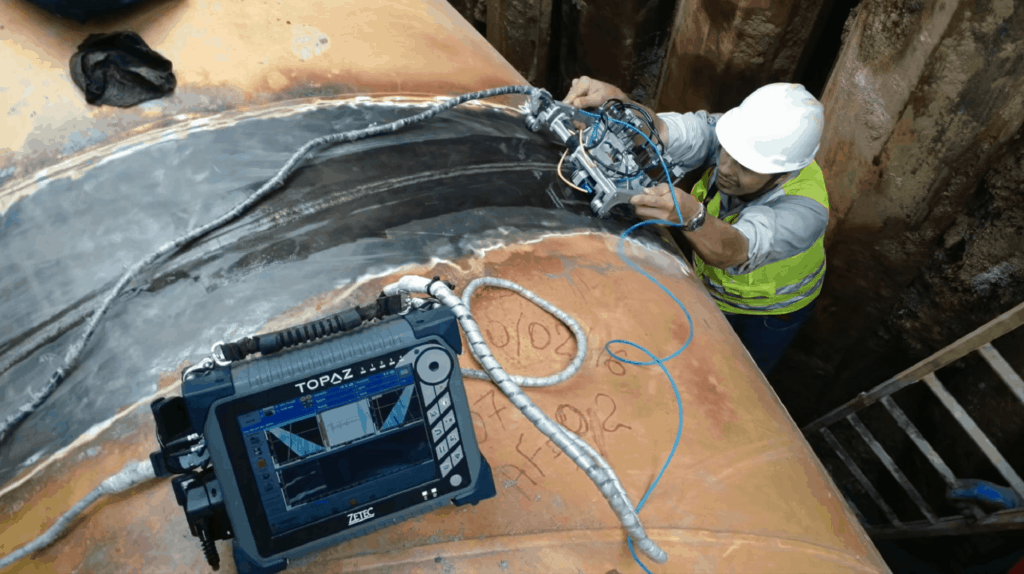Detecting Nonmetallic Inclusions in High Specification Welds with Ultrasonic Testing

The presence of foreign compounds in metal such as steel and alloys can significantly influence its mechanical properties. In welding, such non-metallic inclusions can increase the metals’ susceptibility to cracks and fatigue causing the structure to fail. For safety and quality, the integrity of the weld and overall structure can be inspected through non-destructive testing (NDT).
Ultrasonic testing (UT) is the common choice of industries for volumetric assessment of weld and component quality. Technicians can make use of UT probes to ensure proper weld standards and specifications are being met during or after the production and application of the components.
Non-Metallic Inclusions in Welding
Non-metallic inclusions are the unwanted metallic or non-metallic particles in metals occurring because of chemical reaction or contamination. The non-metallic inclusions can be classified as:
- Endogenous inclusions such as oxides and sulfides, which appear during the desulfurization process as a result of the reaction between the high-temperature metal and deoxidizers like aluminum
- Exogenous inclusions like slag, sand, refractory materials, and flux materials which come from external sources
The properties including size, shape, physical and chemical characteristics, and localization of these inclusions can affect properties of the metal such as strength, machinability, and weldability.
In high specification welding, these non-metallic inclusions may lead to the presence of flaws such as:
- Hot crack formation due to impurities in the weld pool
- Lamellar tearing due to reduction in ductility
- Crack formation in welding due to annealing
- Lack of fusion due to the presence of non-metallic inclusions
The presence of non-metallic inclusion may affect the internal structure of the weld even when the surface may appear to be satisfactory. Detecting these deeply internal flaws can be crucial in ensuring the integrity of critical infrastructures like pipelines in industries such as oil and gas or water supply. Compared to other NDT techniques, ultrasonic testing is an effective non-destructive testing method, preferable in the inspection of high-specification welds and for detecting non-metallic inclusion.
UT Testing for Detecting Weld Flaws
Often, the size distribution and nature of non-metallic inclusion make it very difficult to detect their presence using non-destructive testing. However, phased array ultrasonic testing (PAUT) can detect the internal cracks, flaws, and discontinuities in the material on a volumetric level.
PAUT testing allows the transducers to emit the sound wave of high frequency to be induced and maneuvered along the workpiece. The result is analyzed based on the wave reflected from the metal surface. Any change in the frequency of the reflected wave indicates a weakened area due to the presence of flaws or irregularities in the material. With advanced PAUT instruments, scanners, and probes, technicians can detect the presence of cracks, air bubbles, foreign particles, and lack of fusion. The presence of these flaws in high-specification welds can severely affect the metal quality. With PAUT testing, manufacturers can identify flaws, assess the integrity of a weld and its metal.
Detecting Non-Metallic Inclusion and Weld Flaws with UT Testing
PAUT testing is one of the best methods for detecting the underlying flaws in high-specification welds. These flaws can have critical safety and economic risks attached. The ability to detect flaws through ultrasonic testing facilitates the minimization of such risks.
The advanced PAUT instruments and probes can easily identify the presence of non-metallic inclusions and flaws induced by it in high specification welding. With ultrasonic testing, manufacturers can ensure early detection of difficult-to-detect, internal flaws that can degrade the quality of the metal in the long run and put human lives at risk in critical applications.
Zetec provides ultrasonic testing equipment for detecting non-metallic inclusions in high specification weld inspections. Contact us today to get a custom inspection plan and additional guidance on your NDT needs.





